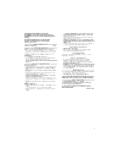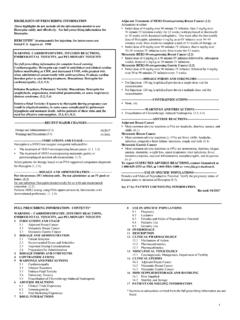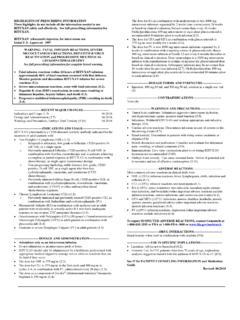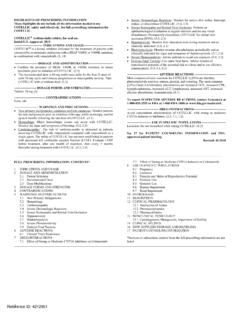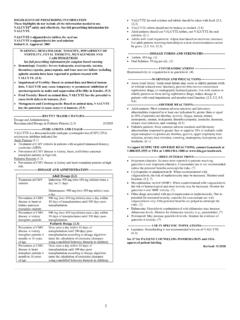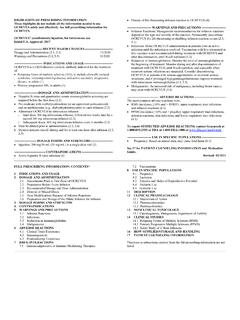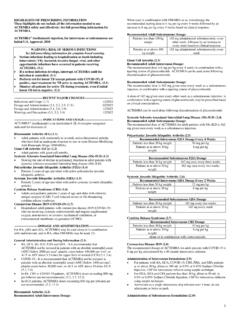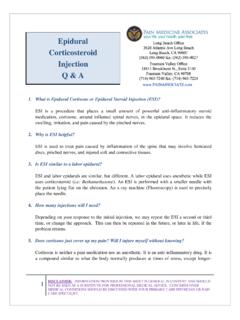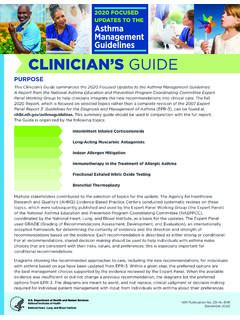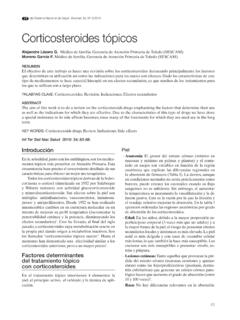Transcription of XOLAIR Prescribing Information - Genentech
1 1 HIGHLIGHTS OF Prescribing Information These highlights do not include all the Information needed to use XOLAIR safely and effectively. See full Prescribing Information for XOLAIR . XOLAIR (omalizumab) injection, for subcutaneous use XOLAIR (omalizumab) for injection, for subcutaneous use Initial Approval: 2003 WARNING: ANAPHYLAXIS See full Prescribing Information for complete boxed warning. Anaphylaxis, presenting as bronchospasm, hypotension, syncope, urticaria, and/or angioedema of the throat or tongue, has been reported to occur after administration of XOLAIR . Anaphylaxis has occurred after the first dose of XOLAIR but also has occurred beyond 1 year after beginning treatment.
2 Initiate XOLAIR therapy in a healthcare setting, closely observe patients for an appropriate period of time after XOLAIR administration and be prepared to manage anaphylaxis which can be life-threatening. Inform patients of the signs and symptoms of anaphylaxis and have them seek immediate medical care should symptoms occur. Selection of patients for self-administration of XOLAIR should be based on criteria to mitigate risk from anaphylaxis. ( , , , ) ---------------------------RECENT MAJOR CHANGES--------------------------- Boxed Warning Indications and Usage ( , ) Dosage and Administration ( , , , , ) Warnings and Precautions ( , , , ) 04/2021 04/2021 04/2021 04/2021 ----------------------------INDICATIONS AND USAGE--------------------------- XOLAIR is an anti-IgE antibody indicated for.
3 Moderate to severe persistent asthma in adults and pediatric patients 6 years of age and older with a positive skin test or in vitro reactivity to a perennial aeroallergen and symptoms that are inadequately controlled with inhaled corticosteroids ( ) Nasal polyps in adult patients 18 years of age and older with inadequate response to nasal corticosteroids, as add-on maintenance treatment ( ) Chronic spontaneous urticaria (CSU) in adults and adolescents 12 years of age and older who remain symptomatic despite H1 antihistamine treatment ( ) Limitations of Use: Not indicated for acute bronchospasm or status asthmaticus.
4 ( , ) Not indicated for other allergic conditions or other forms of urticaria. ( , ) -----------------------DOSAGE AND ADMINISTRATION----------------------- For subcutaneous (SC) administration only. ( , , , ) Divide doses of more than 150 mg among more than one injection site to limit injections to not more than 150 mg per site. ( , ) Asthma: XOLAIR 75 to 375 mg SC every 2 or 4 weeks. Determine dose (mg) and dosing frequency by serum total IgE level (IU/mL), measured before the start of treatment, and body weight (kg). See the dose determination charts. ( ) Nasal Polyps: XOLAIR 75 to 600 mg SC every 2 or 4 weeks.
5 Determine dose (mg) and dosing frequency by serum total IgE level (IU/mL), measured before the start of treatment, and body weight (kg). See the dose determination charts. ( ) Chronic Spontaneous Urticaria: XOLAIR 150 or 300 mg SC every 4 weeks. Dosing in CSU is not dependent on serum IgE level or body weight. ( ) ----------------------DOSAGE FORMS AND STRENGTHS--------------------- Injection: 75 mL and 150 mg/mL solution in a single-dose prefilled syringe (3) For Injection: 150 mg lyophilized powder in a single-dose vial for reconstitution (3) ------------------------------CONTRAINDI CATIONS------------------------------- Severe hypersensitivity reaction to XOLAIR or any ingredient of XOLAIR (4, ) -----------------------WARNINGS AND PRECAUTIONS------------------------ Anaphylaxis.
6 Initiate XOLAIR therapy in a healthcare setting prepared to manage anaphylaxis which can be life-threatening and observe patients for an appropriate period of time after administration. ( ) Malignancy: Malignancies have been observed in clinical studies. ( ) Acute Asthma Symptoms: Do not use for the treatment of acute bronchospasm or status asthmaticus. ( ) corticosteroid Reduction: Do not abruptly discontinue corticosteroids upon initiation of XOLAIR therapy. ( ) Eosinophilic Conditions: Be alert to eosinophilia, vasculitic rash, worsening pulmonary symptoms, cardiac complications, and/or neuropathy, especially upon reduction of oral corticosteroids.
7 ( ) Fever, Arthralgia, and Rash: Stop XOLAIR if patients develop signs and symptoms similar to serum sickness. ( ) ------------------------------ADVERSE REACTIONS------------------------------ Asthma: The most common adverse reactions ( 1% of patients) in clinical studies with adult and adolescent patients 12 years of age were arthralgia, pain (general), leg pain, fatigue, dizziness, fracture, arm pain, pruritus, dermatitis, and earache. In clinical studies with pediatric patients 6 to <12 years of age, the most common adverse reactions were nasopharyngitis, headache, pyrexia, upper abdominal pain, pharyngitis streptococcal, otitis media, viral gastroenteritis, arthropod bites, and epistaxis.
8 ( ) Nasal Polyps: The most common adverse reactions ( 3% of patients) in clinical studies with adult patients included the following: headache, injection site reaction, arthralgia, upper abdominal pain, and dizziness. ( ) Chronic Spontaneous Urticaria: The most common adverse reactions ( 2% of patients) included the following: nausea, nasopharyngitis, sinusitis, upper respiratory tract infection, viral upper respiratory tract infection, arthralgia, headache, and cough. ( ) To report SUSPECTED ADVERSE REACTIONS, contact Genentech at 1-888-835-2555 or FDA at 1-800-FDA-1088 or -------------------------------DRUG INTERACTIONS---------------------------- - No formal drug interaction studies have been performed.
9 (7) See 17 for PATIENT COUNSELING Information and Medication Guide. Revised: 07/2021 FULL Prescribing Information : CONTENTS* WARNING: ANAPHYLAXIS 1 INDICATIONS AND USAGE Asthma Nasal Polyps Chronic Spontaneous Urticaria (CSU) 2 DOSAGE AND ADMINISTRATION Overview of Dosage Determination Recommended Dosage for Asthma Recommended Dosage for Nasal Polyps Recommended Dosage for Chronic Spontaneous Urticaria (CSU) Administration Overview XOLAIR Prefilled Syringe Preparation for Use and Injection of XOLAIR Lyophilized Powder 3 DOSAGE FORMS AND STRENGTHS 4 CONTRAINDICATIONS 5 WARNINGS AND PRECAUTIONS Anaphylaxis Malignancy Acute Asthma Symptoms and Deteriorating Disease corticosteroid Reduction Eosinophilic Conditions Fever, Arthralgia, and Rash Parasitic (Helminth)
10 Infection Laboratory Tests 6 ADVERSE REACTIONS Clinical Trials Experience Immunogenicity Postmarketing Experience 7 DRUG INTERACTIONS 8 USE IN SPECIFIC POPULATIONS Pregnancy Lactation Pediatric Use Geriatric Use 11 DESCRIPTION 12 CLINICAL PHARMACOLOGY 2 Mechanism of Action Pharmacodynamics Pharmacokinetics 13 NONCLINICAL TOXICOLOGY Carcinogenesis, Mutagenesis, Impairment of Fertility 14 CLINICAL STUDIES Asthma Nasal Polyps Chronic Spontaneous Urticaria (CSU) 16 HOW SUPPLIED/STORAGE AND HANDLING 17 PATIENT COUNSELING Information * Sections or subsections omitted from the full Prescribing Information are not listed.
